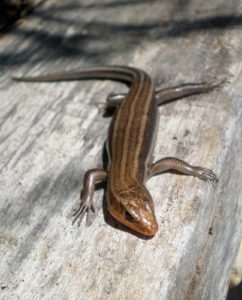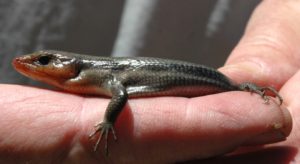Plestiodon fasciatus
Identification
When young, the Common Five-lined Skink has five lengthwise stripes on a black background. The tail is bright blue. The adult females have the same pattern, but it is less distinct, and they lose the blue on the tail. The adult males are dull brown all over. When they are breeding the males have a red throat and sometimes a red face. The adult skinks are between 6 and 8 inches in length.
Get more detailed identification and life history information by downloading the chart here.
You can learn more about this species and see some video footage by checking out this clip from our Rattlers, Peepers & Snappers DVD.
Range/Habitat
[ click image to zoom | download printable PDF ]

[ click image to zoom | download printable PDF ]
The Common Five-lined Skink inhabits rock slides, cliffs, areas near ledges, open woods, old buildings, and is often found near water.
Status
This species has a state natural heritage rank of S1 (rare). The Common Five-lined Skink is endangered in Vermont, and has been designated a Species of Greatest Conservation Need (high priority) in Vermont’s Wildlife Action Plan. Please report all sightings of this species in Vermont. Take photos if possible. Even historic sighting information is useful.
Additional Photos
More Info
The scientific name of the Five-Lined Skink was changed from Eumeces fasciatus to Plestiodon fasciatus in 2007.
- Eumeces fasciatus at the Animal Diversity website
- Eumeces fasciatus in the Vermont Agency of Natural Resources’ Wildlife Action Plan: Amphibian & Reptiles (9/25/2015 draft)
Species summary written by Ariel K. McK. Burgess.







